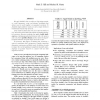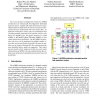74 search results - page 8 / 15 » Jump from Parallel to Sequential Proofs: Multiplicatives |
BMCBI
2008
13 years 7 months ago
2008
Background: Microarray analysis allows the simultaneous measurement of thousands to millions of genes or sequences across tens to thousands of different samples. The analysis of t...
HPCA
2008
IEEE
14 years 8 months ago
2008
IEEE
We apply Amdahl's Law to multicore chips using symmetric cores, asymmetric cores, and dynamic techniques that allows cores to work together on sequential execution. To Amdahl...
SIPS
2008
IEEE
14 years 2 months ago
2008
IEEE
Modern microprocessor technology is migrating from simply increasing clock speeds on a single processor to placing multiple processors on a die to increase throughput and power pe...
ARC
2007
Springer
13 years 11 months ago
2007
Springer
The coarse-grained reconfigurable architecture ADRES (Architecture for Dynamically Reconfigurable Embedded Systems) and its compiler offer high instruction-level parallelism (ILP)...
CJ
2006
13 years 7 months ago
2006
Most microprocessor chips today use an out-of-order instruction execution mechanism. This mechanism allows superscalar processors to extract reasonably high levels of instruction ...


